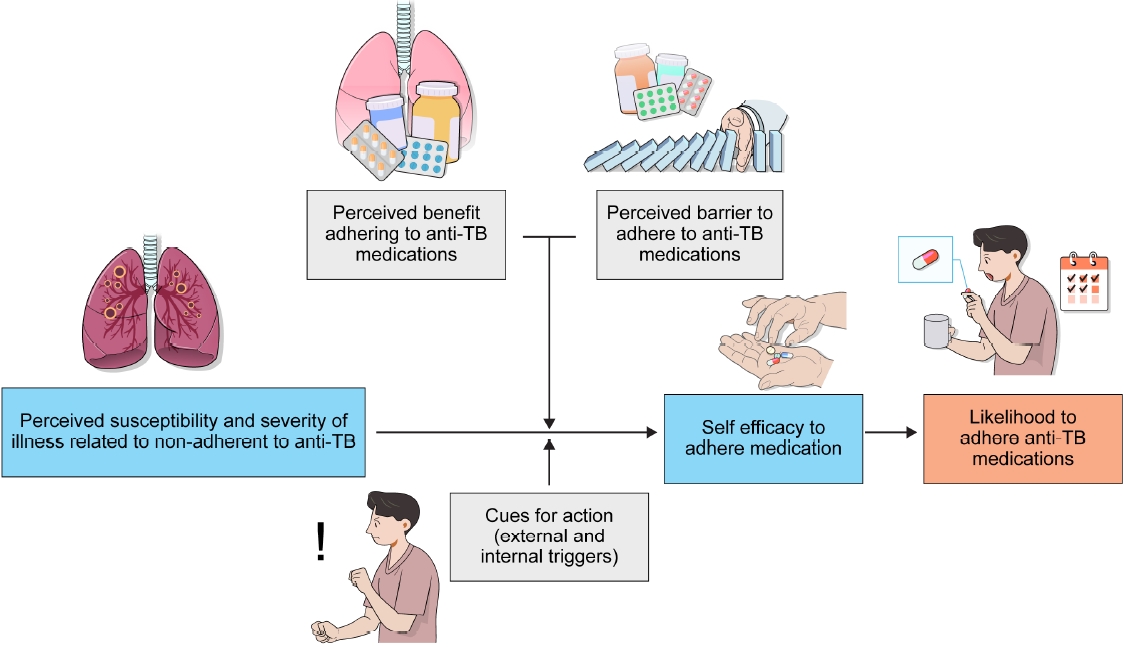3. Cohen A, Mathiasen VD, Schon T, Wejse C. The global prevalence of latent tuberculosis: a systematic review and meta-analysis. Eur Respir J 2019;54:1900655.


4. Ministry of Health Malaysia; Academy of Medicine Malaysia; Malaysian Thoracic Society; World Health Organization. Clinical. Clinical practice guidelines management of tuberculosis 3rd ed [Internet]. Putrajaya: Ministry of Health Malaysia; 2012 [cited 2022 Dec 26]. Available from:
https://www.moh.gov.my/moh/attachments/8612.pdf.
11. Karumbi J, Garner P. Directly observed therapy for treating tuberculosis. Cochrane Database Syst Rev 2015;5:CD003343.

15. Valencia S, Leon M, Losada I, Sequera VG, Fernandez Quevedo M, Garcia-Basteiro AL. How do we measure adherence to anti-tuberculosis treatment? Expert Rev Anti Infect Ther 2017;15:157-65.


18. Dickinson D, Wilkie P, Harris M. Taking medicines: concordance is not compliance. BMJ 1999;319:787.

20. Kigozi G, Heunis C, Chikobvu P, Botha S, van Rensburg D. Factors influencing treatment default among tuberculosis patients in a high burden province of South Africa. Int J Infect Dis 2017;54:95-102.


27. Nguyen TA, Pham MT, Nguyen TL, Nguyen VN, Pham DC, Nguyen BH, et al. Video directly observed therapy to support adherence with treatment for tuberculosis in Vietnam: a prospective cohort study. Int J Infect Dis 2017;65:85-9.


29. Du L, Chen X, Zhu X, Zhang Y, Wu R, Xu J, et al. Determinants of Medication adherence for pulmonary tuberculosis patients during continuation phase in Dalian, Northeast China. Patient Prefer Adherence 2020;14:1119-28.


33. Zhang J, Yang Y, Qiao X, Wang L, Bai J, Yangchen T, et al. Factors influencing medication nonadherence to pulmonary tuberculosis treatment in Tibet, China: a qualitative study from the patient perspective. Patient Prefer Adherence 2020;14:1149-58.


35. Albasheer OB, Mahfouz MS, Solan Y, Khan DA, Muqri MA, Almutairi HA, et al. Depression and related risk factors among patients with type 2 diabetes mellitus, Jazan area, KSA: a cross-sectional study. Diabetes Metab Syndr 2018;12:117-21.


37. Azniza MR, Draman N, Siti Suhaila MY, Muhamad R. Depression and potential risk factors among the elderly with type 2 diabetes mellitus in Kedah, Malaysia. Med J Malaysia 2019;74:103-8.

38. Yang TW, Park HO, Jang HN, Yang JH, Kim SH, Moon SH, et al. Side effects associated with the treatment of multidrug-resistant tuberculosis at a tuberculosis referral hospital in South Korea: a retrospective study. Medicine (Baltimore) 2017;96:e7482.


39. Dar SA, Shah NN, Wani ZA, Nazir D. A prospective study on quality of life in patients with pulmonary tuberculosis at a tertiary care hospital in Kashmir, Northern India. Indian J Tuberc 2019;66:118-22.


44. Ratchakit-Nedsuwan R, Nedsuwan S, Sawadna V, Chaiyasirinroje B, Bupachat S, Ngamwithayapong-Yanai J, et al. Ensuring tuberculosis treatment adherence with a mobile-based CARE-call system in Thailand: a pilot study. Infect Dis (Lond) 2020;52:121-9.


45. Guo P, Qiao W, Sun Y, Liu F, Wang C. Telemedicine technologies and tuberculosis management: a randomized controlled trial. Telemed J E Health 2020;26:1150-6.


49. Bestrashniy JR, Nguyen VN, Nguyen TL, Pham TL, Nguyen TA, Pham DC, et al. Recurrence of tuberculosis among patients following treatment completion in eight provinces of Vietnam: a nested case-control study. Int J Infect Dis 2018;74:31-7.


50. Lee HK, Teo SSH, Barbier S, Tang SC, Yeo GH, Tan NC. The impact of direct observed therapy on daily living activities, quality of life and socioeconomic burden on patients with tuberculosis in primary care in Singapore. Proc Singap Healthc 2016;25:235-42.


52. Bojorquez I, Salazar I, Garfein RS, Cerecer P, Rodwell TC. Surveillance or support: the experience of direct observation during tuberculosis treatment. Glob Public Health 2018;13:804-18.


56. Garfein RS, Collins K, Munoz F, Moser K, Cerecer-Callu P, Raab F, et al. Feasibility of tuberculosis treatment monitoring by video directly observed therapy: a binational pilot study. Int J Tuberc Lung Dis 2015;19:1057-64.


59. Maiman LA, Becker MH. The health belief model: origins and correlates in psychological theory. Health Educ Monogr 1974;2:336-53.


60. Ashraf M, Virk RN. Determinants of medication adherence in patients with HIV: application of the health belief model. J Pak Med Assoc 2021;71:1409-12.

61. Wang MY, Shen MJ, Wan LH, Mo MM, Wu Z, Li LL, et al. Effects of a comprehensive reminder system based on the health belief model for patients who have had a stroke on health behaviors, blood pressure, disability, and recurrence from baseline to 6 months: a randomized controlled trial. J Cardiovasc Nurs 2020;35:156-64.


62. Yue Z, Li C, Weilin Q, Bin W. Application of the health belief model to improve the understanding of antihypertensive medication adherence among Chinese patients. Patient Educ Couns 2015;98:669-73.


63. Kung PC, Yeh MC, Lai MK, Liu HE. Renal transplant recipients: the factors related to immunosuppressive medication adherence based on the health belief model. J Nurs Res 2017;25:392-7.


65. Alatawi YM, Kavookjian J, Ekong G, Alrayees MM. The association between health beliefs and medication adherence among patients with type 2 diabetes. Res Social Adm Pharm 2016;12:914-25.


67. Sellares J, de Freitas DG, Mengel M, Reeve J, Einecke G, Sis B, et al. Understanding the causes of kidney transplant failure: the dominant role of antibody-mediated rejection and nonadherence. Am J Transplant 2012;12:388-99.


70. Prasetya H, Murti B, Anantanyu S, Syamsulhadi M. The effect of hypnosis on adherence to antituberculosis drugs using the health belief model. Int J Clin Exp Hypn 2018;66:211-27.











 PDF Links
PDF Links PubReader
PubReader ePub Link
ePub Link Data Sharing Statement
Data Sharing Statement Full text via DOI
Full text via DOI Print
Print Download Citation
Download Citation



